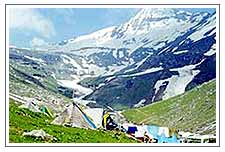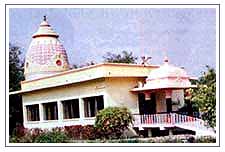Kullu was once known as "Kulanthpitha", which means the end of
the habitable world. Beyond rose the forbidding heights of the Greater
Himalayas, and by the banks of the shining river Beas, lay the fabled
'Silver Valley' of Kulu. Here is the core of an intricate web of numerous
valleys - each of which is a visual delight and seems more beautiful than
the other. The Himalayan mountain scapes remain spectacular whether in
brilliant sunshine or in the haze of the mist.

The town of Kullu has long been a centre of faith. In the 17th century,
Raja Jagat Singh installed here an idol of Lord Raghunathji, which he
brought from Ayodhya. As a mark of his penance, he placed the idol on his
throne and it became the presiding deity of the Kullu valley.
The town of Kulu is famous for its colourful Dussehra festival. Decorated
palanquins and processions convey Gods and Goddesses from temples all over
the valley to Kullu, to pay homage to the reigning deity, Raghunathji. A
Fair springs up during the festival which is celebrated with a great deal of
singing, dancing and festivity.
Places Of Interest In Kullu
Raghunathji
Temple:
In the 17th century, Raja Jagat Singh of Kulu committed a great wrong. To
atone for the sin he sent a senior courtier to Ayodhya for a statue of Lord
Raghunath - Lord Ram. This temple was built by Raja Jagat Singh to house the
image and even today, is greatly revered. The shrine houses an image of Shri
Raghunath in his chariot.
Bijli Mahadev Temple:
Set on a spur that offers some spectacular views, this temple is famous for
its 20m high rod that periodically draws lightning, which shatters the
'Shivalinga' and scorches the building. Using only butter as adhesive, the
'linga' is then carefully pieced together by the temple pundit.
Naggar:
For 1,400 years Naggar remained the capital of Kullu. Its 16th century
stone and wood castle is now a hotel run by Himachal Tourism. Here, a
gallery houses the paintings of the Russian artist, Nicholas Roerich. Naggar
also has three other old shrines.
Parvati Valley & Manikarna:
At 1,737 m, here am hot sulphur springs that bubble next to the by waters
of the Penal river. The place is revered by both Hindus and Sikhs Treks from
here lead to Pulga, Khirganga and Mantalai' a stretch of considerable
natural beauty. The route finally reaches the Pin Parvati Pass (4802 m),
which opens into the Sutlej valley.
 Jagatsukh :
Jagatsukh :
Jagatsukh is the most ancient Kullu capital, situated on the left bank,
between Nagar and Manali. Around the Jagatsukh secondary school playground
there are two ancient temples - the small shrine of Gaurishankar and the
larger chalet-roofed temple to the goddess Sandhya Devi, the stone base of
which is much more ancient than the 19th-century wooden verandah and roof.
Deo Tibba:
Also known as Indralika, this 2,953 metres (9,687 ft.) high snow dove
Jagatsukh, has a legend around it, with Arjuna. He started performing 'tapa'
at this mountain, under the advice of Maharishi Vyas, in order to obtain the
powerful Pasupata Astra from Indra.
Angling
& Fishing in Kullu:
Kasol:
An open glade by the banks of the river Parvati, Kasol makes a good holiday
destination. Clean white sand separates the lush green grass from the stone,
this place is well known for trout fishing.
Raison:
By the banks of the Beas-and on the Kullu-Manali Highway- Himachal Tourism
runs a camping site here. This place is ideal for a taste of adventure and
for spending a quiet holiday in solitary splendour.
Katrain:
At about midpoint on Kullu-Manali road, this is the home of lush orchards
and famous for bee-keeping and trout fishing. Khatrain is the widest point
in Kullu Valley and is overlooked by the 3,325 m Baragarh peak.
Largi:
Largi is a small hamlet, 34-km south of Kulu via Aut, offers the best trout
fishing and scenic beauty in the valley. The resthouse there is in a
stunning location where two Himalayan torrents, the Sainj and Tirthan, meet.
Fishing permits can be obtained from Kullu and Largi itself.
 Banjar:
Banjar:
It is about 58-km from Kulu at an altitude of 1,534m (5,000 ft.). Banjar is
famous for its panoramic beauty and trout fishing in river Tirtham.
Bathad:
A beautiful spot at a distance of 67-km can be approached by road from
Kullu. It is recognized for adventurous games such as hunting, trout fishing
and breathtakingly beautiful sites.
Trekking in Kullu
The valley is the nucleus of several trek routes. Some major ones are over
the Chanderkhani Pass to Malana and Pin Parbati Pass to Sarahan. The Jalora
Pass lies 5-km beyond Shoja and gives access to the outer Seraj region of
the Kullu Valley. From Chamba to Udaipur (Lahaul) over Sach Pass, can be
completed by trekkers within a day span of nine or ten days.
Air:
The airport at Bhuntar is 10-km from Kullu, where taxis and buses are
available.
Rail:
The closest narrow gauge railhead is at Jogindernagar, 95-km from Kullu.
Road:
By road, the distance from Delhi via Mandi is 530-km and from Shimla this
is 240-km. From Delhi and Shimla, luxury buses ply to Kulu. There's a bus
and taxi stand on the opposite side of maidan. The main bus stand is by
river in the northern area of the town.
DISTANCE FROM MAJOR CITIES
Kasidhar: 15-km
»Kasol: 42-km
»Manikaran: 45-km
»Shoja: 69-km
»Raison: 13-km
»Naggar: 23-km
»Manali:
40-km



 Jagatsukh :
Jagatsukh :